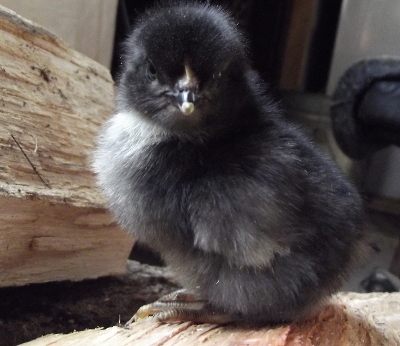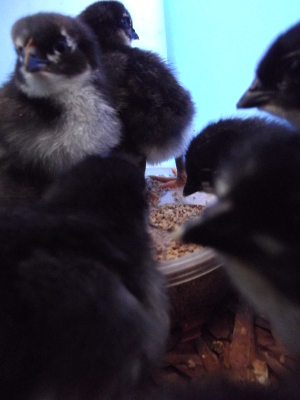
Long hatch and hybrid vigor
 We've had a strangely
elongated hatch this time around, which I think is due to cold weather
exacerbating differences
in temperature within the incubator. But it's hard to
complain when the final count is 18 living chicks, two yolkers (which
were either infertile or died very young), and one fully formed but
dead in the shell chick. (It's possible even that last guy might
have hatched, but I thought for sure he was dead when he hadn't pipped
by the end of day 23!)
We've had a strangely
elongated hatch this time around, which I think is due to cold weather
exacerbating differences
in temperature within the incubator. But it's hard to
complain when the final count is 18 living chicks, two yolkers (which
were either infertile or died very young), and one fully formed but
dead in the shell chick. (It's possible even that last guy might
have hatched, but I thought for sure he was dead when he hadn't pipped
by the end of day 23!)
Most of the chicks have australorp
fathers and mothers, but two have sussex and seven have marans
mothers. You know how humans take one look at the squashed up
 face of a newborn baby and immediately say it looks like the father
(seldom the mother)? Well, I thought the same of our little
hybrids at first. But soon I noticed that some appeared blacker
than others, making me think those are the maransXaustralorp
chicks. I wonder if I'll see signs of hybrid vigor when the time
comes to weigh then eat them?
face of a newborn baby and immediately say it looks like the father
(seldom the mother)? Well, I thought the same of our little
hybrids at first. But soon I noticed that some appeared blacker
than others, making me think those are the maransXaustralorp
chicks. I wonder if I'll see signs of hybrid vigor when the time
comes to weigh then eat them?
(As you can tell, the
creek went down enough that I could bring in the chick feed. Our
youngsters thought the milled grain was almost as interesting as hard-boiled
egg yolks, but they
spilled it pretty badly until I made a homemade feeder. More on
that eventually if it works.)
Want more in-depth information? Browse through our books.
Or explore more posts by date or by subject.
About us: Anna Hess and Mark Hamilton spent over a decade living self-sufficiently in the mountains of Virginia before moving north to start over from scratch in the foothills of Ohio. They've experimented with permaculture, no-till gardening, trailersteading, home-based microbusinesses and much more, writing about their adventures in both blogs and books.
Want to be notified when new comments are posted on this page? Click on the RSS button after you add a comment to subscribe to the comment feed, or simply check the box beside "email replies to me" while writing your comment.

what a beautiful boy! congrats on a very successful hatch! sounds like you might want to buy a clutch of eggs, maybe in May, to introduce another bloodline in the fall/winter.
we recently purchased year old layers from a farm in Petaluma - an hour north. they replaced girls that were hand raised in our yard that we culled mid-fall and winter.
http://i.imgur.com/I35CZ.jpg
I think homegrown really helped with my hatch rate and the ease with which our chicks pushed out of their shells.
Ordering hatching eggs to get a new rooster for the next year makes sense, but I'd hate to risk changing half of my genetics to what might be a dud when our current rooster is such a gentleman! I guess I'll ponder for a while...
Looks like you got some good hens!
Dave B3 --- Thanks for the interesting link! I'm not so sure it proves that it's okay to breed fathers to daughters, though.
I think that sibling breeding is slightly less likely to pair up bad recessive genes than father-daughter breeding, if I'm thinking this through right. The father gives 50% of his genes to his daughter, so they definitely share 50% of the same genes. On the other hand, siblings share an average of 50% of the same genes, but that amount could vary from 0% to 100%. (That's why some siblings look much more alike than others.)
So, the author of the website could have gotten lucky and bred siblings that shared less of their DNA. (And I also noticed that he only inbred once, sandwiched between two sets of extreme outbreeding.)
The trouble with line-breeding/inbreeding is that if bad recessive traits pair up, you could end up with some really troubled birds. If you're willing to cull them relentlessly, that's okay, but it does add an element of hard-heartedness I'm not sure I'm ready for.